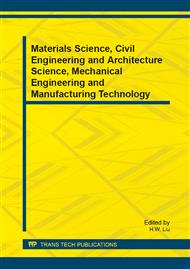[1]
R. -j. Lin and C. Sheu, Why Do Firms Adopt/Implement Green Practices?–An Institutional Theory Perspective, Procedia - Social and Behavioral Sciences, vol. 57, pp.533-540, (2012).
DOI: 10.1016/j.sbspro.2012.09.1221
Google Scholar
[2]
L. Shen, L. Olfat, K. Govindan, R. Khodaverdi, and A. Diabat, A fuzzy multi criteria approach for evaluating green supplier's performance in green supply chain with linguistic preferences, Resources, Conservation and Recycling, vol. 74, pp.170-179, (2013).
DOI: 10.1016/j.resconrec.2012.09.006
Google Scholar
[3]
K. Govindan, R. Khodaverdi, and A. Jafarian, A fuzzy multi criteria approach for measuring sustainability performance of a supplier based on triple bottom line approach, Journal of Cleaner Production, vol. 47, pp.345-354, (2013).
DOI: 10.1016/j.jclepro.2012.04.014
Google Scholar
[4]
E. Herrera-Viedma, F. Herrera, F. Chiclana, and M. Luque, Some issues on consistency of fuzzy preference relations, European Journal of Operational Research, vol. 154, pp.98-109, (2004).
DOI: 10.1016/s0377-2217(02)00725-7
Google Scholar
[5]
F. Chiclana, F. Herrera, and E. Herrera-Viedma, Integrating three representation models in fuzzy multipurpose decision making based on fuzzy preference relations, Fuzzy Sets and Systems, vol. 97, pp.33-48, (1998).
DOI: 10.1016/s0165-0114(96)00339-9
Google Scholar
[6]
F. Herrera, E. Herrera-Viedma, and J. L. Verdegay, A sequential selection process in group decision making with a linguistic assessment approach, Information Sciences, vol. 85, pp.223-239, (1995).
DOI: 10.1016/0020-0255(95)00025-k
Google Scholar
[7]
F. Herrera, E. Herrera-Viedma, and J. L. verdegay, A model of consensus in group decision making under linguistic assessments, Fuzzy Sets and Systems, vol. 78, pp.73-87, (1996).
DOI: 10.1016/0165-0114(95)00107-7
Google Scholar
[8]
F. Herrera, E. Herrera-Viedma, and J. L. Verdegay, A rational consensus model in group decision making using linguistic assessments, Fuzzy Sets and Systems, vol. 88, pp.31-49, (1997).
DOI: 10.1016/s0165-0114(96)00047-4
Google Scholar
[9]
T. Tanino, Fuzzy preference orderings in group decision making, Fuzzy Sets and Systems, vol. 12, pp.117-131, (1984).
DOI: 10.1016/0165-0114(84)90032-0
Google Scholar
[10]
Z. Switalski, General transitivity conditions for fuzzy reciprocal preference matrices, Fuzzy Sets and Systems, vol. 137, pp.85-100, (2003).
DOI: 10.1016/s0165-0114(02)00434-7
Google Scholar
[11]
Y. Dong, H. Li, and Y. Xu, On reciprocity indexes in the aggregation of fuzzy preference relations using the OWA operator, Fuzzy Sets Syst., vol. 159, pp.185-192, (2008).
DOI: 10.1016/j.fss.2007.06.010
Google Scholar


